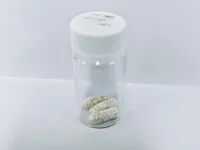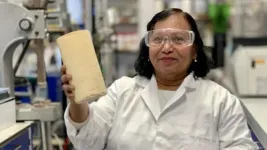(Press-News.org) There are approximately 425 million people worldwide with diabetes. Approximately 75 million of these inject themselves with insulin daily. Now they may soon have a new alternative to syringes or insulin pumps. Scientists have found a new way to supply the body with smart insulin.
The new insulin can be eaten by taking a capsule or even better, within a piece chocolate.
Inside these we find tiny nano-carriers to which the insulin is encapsulated. The particles are 1/10,000th the width of a human hair and so small that you cannot even see them under a normal microscope.
“This way of taking insulin is more precise because it delivers the insulin rapidly to the areas of the body that need it most. When you take insulin with a syringe, it is spread throughout the body where it can cause unwanted side effects,” explains Professor Peter McCourt at UiT Norway's Arctic University. He is one of the researchers behind the study.
The research was recently published in Nature Nanotechnology.
Delivered to the liver
It was researchers at the University of Sydney and Sydney Local Health District who, in collaboration with UiT, discovered many years ago that it was possible to deliver medicines via nano-carriers to the liver. The method has then been further developed in Australia and in Europe.
Many medicines can be taken by mouth, but until now people have had to inject insulin into the body. McCourt explains that the problem with insulin with a nano-carrier is that it breaks down in the stomach and thus does not get to where it is needed in the body. This has been a major challenge for developing a diabetes medicine that can be taken orally.
But now the researchers have solved this challenge.
“We have created a coating to protect the insulin from being broken down by stomach acid and digestive enzymes on its way through the digestive system, keeping it safe until it reaches its destination, namely the liver,” says McCourt, who is a liver biologist.
The coating is then broken down in the liver by enzymes that are active only when the blood sugar levels are high, releasing the insulin where it can then act in the liver, muscle, and fat to remove sugar from the blood.
“This means that when blood sugar is high, there is a rapid release of insulin, and even more importantly, when blood sugar is low, no insulin is released,” says Nicholas J. Hunt at the University of Sydney who, together with Victoria Cogger, leads the project.
He explains that this is a more practical and patient-friendly method of managing diabetes because it greatly reduces the risk of a low blood sugar event occurring, namely hypoglycemia and allows for the controlled released of insulin depending on the patient’s needs, unlike injections where all the insulin is released in one shot.
Fewer side effects
The new method works similarly to how insulin works in healthy people. The pancreas produces insulin which first passes through the liver where a large portion of it is absorbed and maintains stable blood sugar levels. In the new insulin method, the nano-carrier releases insulin in the liver, where it can be taken up or enter the blood to circulate in the body.
“When you inject insulin under the skin with a syringe, far more of it goes to the muscles and to adipose tissues that would normally happen if it was released from the pancreas, which can lead to the accumulation of fats. It can also lead to hypoglycemia, which can potentially be dangerous for people with diabetes.
With the new method, there will be fewer such side effects.
In addition, you do not need to stab yourself with a needle and you can take the medicine you need in a slightly more discreet way. Also, this form of insulin does not need to be refrigerated.
Tested on baboons
The oral insulin has been tested on nematodes, on mice and rats. And lastly, the medicine has now been tested on baboons in the National Baboon Colony in Australia.
“In order to make the oral insulin palatable we incorporated it into sugar-free chocolate, this approach was well received” says Hunt.
He says that 20 baboons have taken part in this study. When they received the medicine, their blood sugar was lowered.
The baboons were normal, healthy baboons, but the oral insulin have also been tested on mice and rats that actually have diabetes. The mice and rats did not have low blood sugar events (hypoglycemia), gain weight or fat accumulation in the liver overcoming current challenges with injectable and other oral insulins.
What remains now is to test the new method on humans.
Ready for use in 2-3 years
“Trials on humans will start in 2025 led by the spin out company Endo Axiom Pty Ltd. Clinical trials are performed in 3 phases; in the phase I trial we will investigate the safety of the oral insulin and critically look at the incidence of hypoglycemia in healthy and type 1 diabetic patients. Our team is very excited to see if we can reproduce the absent hypoglycemia results seen in baboons in humans as this would be a huge step forward. The experiments follow strict quality requirements and must be carried out in collaboration with physicians to ensure that they are safe for the test subjects” says Hunt.
“After this phase I we will know that it is safe for humans and will investigate how it can replace injections for diabetic patients in phase 2 trials,” says the researcher.
The researchers hope that the new medicine can be ready for use by everyone in 2-3 years.
END
New medicine can create a new life for diabetes patients – without needles!
Scientists have made promising discoveries and the new insulin medicine is ready to be tested on humans in 2025
2024-01-19
ELSE PRESS RELEASES FROM THIS DATE:
Miami Cancer Institute publication analyzes role of tissue-agnostic therapies for the treatment of primary brain tumors
2024-01-19
MIAMI, FL – January 19, 2024 – Researchers from Miami Cancer Institute, part of Baptist Health South Florida, today published a study in Trends in Cancer that analyzes the use of tissue-agnostic therapeutics in patients with primary brain tumors (PBTs). The publication describes the current and potential impact of tissue-agnostic therapies on the management of PBTs. As part of the publication, the researchers discuss data from clinical trials of tissue-agnostic targets for PBTs in the context of challenges in managing these tumors. They also describe additional tissue-agnostic ...
Discovery unravels the mystery of a rare bone disease
2024-01-19
A McGill-led team of researchers have made an important discovery shedding light on the genetic basis of a rare skeletal disorder. The study, published in Nature Communications, reveals that a defect in a specific gene (heterozygous variants in the matrix Gla protein, or MGP) may cause a disorder that affects the structure of connective tissues that supports the body.
MGP is a special protein found in blood vessels and cartilage that helps prevent the hardening of these tissues in the body. If MGP is completely missing, it can lead to Keutel syndrome, a rare condition where tissues become calcified, causing issues in the skeleton and blood vessels.
However, in this case, ...
Infantile spasms: Speeding referrals for all infants
2024-01-19
Infantile epileptic spasms syndrome (IESS), often called infantile spasms, is the most common form of epilepsy seen during infancy. Prompt diagnosis and referral to a neurologist are essential. But research suggests infants are likely to experience delays in referral to a neurologist if their families are from historically marginalized racial/ethnic backgrounds. A new open-access training module for front-line providers from OPENPediatrics, an online learning community launched by Boston Children’s Hospital, aims to change that.
The free, publicly accessible Infantile Spasms curriculum includes short lectures and videos illustrating ...
China’s medieval Tang dynasty had a surprising level of social mobility, new study uncovers
2024-01-19
In studying social mobility in today’s industrialized nations, researchers typically rely on data from the World Economic Forum or, in the United States, the General Social Survey. But examining the same phenomena from past centuries is a more daunting task because relevant statistics are harder to come by.
However, a social science research team has now discovered a way to examine professional advancement in medieval China (618-907 CE) by drawing from the tomb epitaphs during the Tang Dynasty. These epitaphs contain the ancestral lineages, names, and office titles (e.g., Minister of Personnel, Minister of the Court of Judicial Review, and ...
Research into the nature of memory reveals how cells that store information are stabilized over time
2024-01-19
BUFFALO, N.Y. – Think of a time when you had two different but similar experiences in a short period. Maybe you attended two holiday parties in the same week or gave two presentations at work. Shortly afterward, you may find yourself confusing the two, but as time goes on that confusion recedes and you are better able to differentiate between these different experiences.
New research published in Nature Neuroscience published on January 19, reveals that this process occurs on a cellular level, findings that are critical to ...
Generative AI helps to explain human memory and imagination
2024-01-19
Recent advances in generative AI help to explain how memories enable us to learn about the world, re-live old experiences and construct totally new experiences for imagination and planning, according to a new study by UCL researchers.
The study, published in Nature Human Behaviour and funded by Wellcome, uses an AI computational model – known as a generative neural network - to simulate how neural networks in the brain learn from and remember a series of events (each one represented by a simple scene).
The ...
KIST's 'Moonwalk', a robot that makes climbing Bukhansan Mountain easier
2024-01-19
As people age, they gradually lose muscle strength in their arms and legs, making it difficult for them to participate in leisure activities such as hiking and traveling, and they often need to rely on assistive devices such as canes and wheelchairs for mobility. However, these assistive devices do not improve muscle strength, so wearable robots that can compensate for the lack of muscle strength with the help of robots are attracting attention as an innovative technology to improve the health and quality of life of the elderly.
Dr. Lee Jongwon of the Intelligent Robotics Research Center at the Korea Institute of Science and Technology(KIST) ...
New air purifier design with innovative foam technology promises virus-stopping performance and zero waste
2024-01-19
Researchers at the University of Bath have invented a new form of high-performance air purifier that promises zero harmful waste.
Key to the purifier and how it works is FOAM3R filter technology, patented by the University, which is described as a highly adaptable disruptor technology for microbial, CO2 and volatile organic compound (VOC) odour removal.
FOAM3R can be used to produce multi-functional foam structures for a wide range of applications, including aircraft cabins, in-car air filters, ship and boat cabins, residential heating, ventilation and air-conditioning, home air purifiers and respirator and breathing apparatus.
The ...
Survey offers insights on childlessness and childcare in the UK
2024-01-19
Young people are increasingly planning to not have children
Millennials with stronger environmental concerns are less likely to intend to have a child, but this isn’t the case for Gen Z
Lower-income families spend more of their income on childcare than wealthier households
Parents pay an average of £560 a month on childcare – with a quarter paying over £800
A comprehensive new survey reveals the changing face of UK families amid recent economic, social, and political turmoil.
The methodology and initial findings from the UK Generations and Gender Survey are being presented today [Friday 19th January] ...
New study is one of first to show people with evidence of any remission of diabetes from weight-loss trial had a 40% lower rate of cardiovascular disease and 33% lower rate of chronic kidney disease
2024-01-19
While several trials have shown that substantial weight loss using diet and lifestyle can reverse type 2 diabetes, new research published in Diabetologia (the journal of the European Association of the Study of Diabetes [EASD]) is among the first to show the subsequent impact of remission on cardiovascular outcomes. The study is by Professor Edward Gregg, Head of the School of Population Health, RCSI University of Medicine and Health Sciences, Dublin, Ireland, and colleagues.
The new study shows that in patients that took part in the Look ...
LAST 30 PRESS RELEASES:
Heart-brain connection: international study reveals the role of the vagus nerve in keeping the heart young
Researchers identify Rb1 as a predictive biomarker for a new therapeutic strategy in some breast cancers
Survey reveals ethical gaps slowing AI adoption in pediatric surgery
Stimulant ADHD medications work differently than thought
AI overestimates how smart people are, according to HSE economists
HSE researchers create genome-wide map of quadruplexes
Scientists boost cell "powerhouses" to burn more calories
Automatic label checking: The missing step in making reliable medical AI
Low daily alcohol intake linked to 50% heightened mouth cancer risk in India
American Meteorological Society announces Rick Spinrad as 2026 President-Elect
Biomass-based carbon capture spotlighted in newly released global climate webinar recording
Illuminating invisible nano pollutants: advanced bioimaging tracks the full journey of emerging nanoscale contaminants in living systems
How does age affect recovery from spinal cord injury?
Novel AI tool offers prognosis for patients with head and neck cancer
Fathers’ microplastic exposure tied to their children’s metabolic problems
Research validates laboratory model for studying high-grade serous ovarian cancer
SIR 2026 delivers transformative breakthroughs in minimally invasive medicine to improve patient care
Stem Cell Reports most downloaded papers of 2025 highlight the breadth and impact of stem cell research
Oxford-led study estimates NHS spends around 3% of its primary and secondary care budget on the health impacts of heat and cold in England
A researcher’s long quest leads to a smart composite breakthrough
Urban wild bees act as “microbial sensors” of city health.
New study finds where you live affects recovery after a hip fracture
Forecasting the impact of fully automated vehicle adoption on US road traffic injuries
Alcohol-related hospitalizations from 2016 to 2022
Semaglutide and hospitalizations in patients with obesity and established cardiovascular disease
Researchers ‘listen in’ to embryo-mother interactions during implantation using a culture system replicating the womb lining
How changing your diet could help save the world
How to make AI truly scalable and reliable for real-time traffic assignment?
Beyond fragmented markets: A new framework for efficient and stable ride-pooling
Can shape priors make road perception more reliable for autonomous driving?
[Press-News.org] New medicine can create a new life for diabetes patients – without needles!Scientists have made promising discoveries and the new insulin medicine is ready to be tested on humans in 2025





